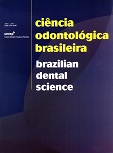Etching time evaluation on the shear bond strength of two adhesive systems in primary teeth
DOI:
https://doi.org/10.14295/bds.2004.v7i3.302Abstract
Purpose: to evaluate the effect of the etching time and adhesive systems on the shear bond strength in primary teeth. Methodology: 48 sound primary teeth (USP teeth bank) were used. They were longitudinally sectioned (mesio-distal direction) and embedded in epoxy resin, leaving the buccal or lingual surface externally. The specimens were ground flat until dentin. They were randomly divided into 3 groups according to the etching time (7, 15 and 20 s) and the adhesive system used (Scotchbond Multipurpose Plus - SBMP and Prime & Bond 2.1 - PB): G1 - 7s + SBMP; G2 - 15 s + SBMP; G3 - 20 s + SBMP; G4 - 7 s + PB; G5 - 15 s + PB; G6 - 20 s + PB. Next the teeth were restored (Z100), on the dentin surface and stored in distilled water (37oC, for 72h). Then, the specimens were submitted to the SBS test in an Instron machine (0.5 mm/min). The fracture sites were analyzed in a Stereomicroscopic and SEM. The values for the SBS test were submitted to ANOVA and Tukey tests (p<0.05). Results: the SBS was higher for the 7s time groups. However, no statistical difference was observed when SBwas used. The PB system showed higher values of SBS at 7 and 15s (p<0.05). The adhesive failure (86.5%) was more frequent. Conclusion: 1 - The interaction material versus time showed that for the SBMP the performance of the system did not vary due to the etching time, while for the PB the best results were found for the lower times of acid etching; 2 - The analysis of fractured sites showed that the most frequently failure type found was the adhesive type (86.5%); 3 - The larger the etching time the lower the shear bond strength values for the PB adhesive system.
Downloads
Downloads
Published
How to Cite
Issue
Section
License
Brazilian Dental Science uses the Creative Commons (CC-BY 4.0) license, thus preserving the integrity of articles in an open access environment. The journal allows the author to retain publishing rights without restrictions.
=================




























